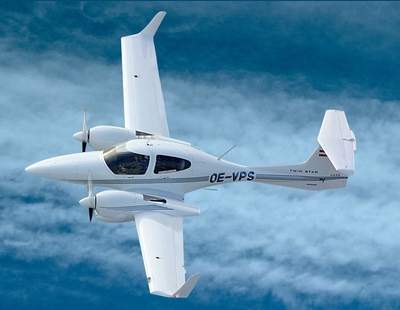Thu, Jun 01, 2017
Fractured Exhaust Pipes Led To Uncommanded Engine Shutdowns In Two Cases
The FAA has issued an Airworthiness Directive (AD) for Diamond Aircraft Industries GmbH Model DA 42 airplanes following a similar MCAI action by EASA.

According to the AD (2017-11-08), two cases have been reported of uncommanded engine in-flight shutdown (IFSD) on DA 42 airplanes. Subsequent investigations identified that these occurrences were due to failure of the propeller regulating valve, caused by hot exhaust gases coming from fractured engine exhaust pipes. The initiating cracks on the exhaust pipes were not detected during previous inspections, since those exhaust pipes are equipped with nonremovable heat shields that do not allow inspection for certain sections of the exhaust pipe.
This condition, if not corrected, could lead to further cases of IFSD or overheat damage, possibly resulting in a forced landing, with consequent damage to the aeroplane and injury to occupants.
To address this potential unsafe condition, Diamond Aircraft Industries (DAI) developed an exhaust pipe without a directly attached integral heat shield that allows visual inspection over the entire exhaust pipe length. DAI issued Mandatory Service Bulletin (MSB) 42-120 and relevant Working Instruction (WI) WI-MSB 42-120, providing instructions to install the modified exhaust pipes. As an interim measure, an additional bracket was designed to hold the exhaust pipe in place in case of a pipe fracture. EASA issued AD 2016-0156 (later revised), requiring replacement of the exhaust pipes with pipes having the new design, or installation of the additional brackets.
Since EASA AD 2016-0156R1 was issued, cracks were found during inspection on modified exhaust pipes. Further investigation determined that, with the modified exhaust pipe design, vibration leads to cracking.
To address this potential unsafe condition, DAI published MSB 42-129 providing instructions for inspection of modified exhaust pipes.
The MCAI allows for either replacement or repair if a cracked exhaust pipe is found during an inspection. This AD will only allow for replacement. If there were to become a parts availability issue at some time, we would consider the welding repair as an alternative method of compliance.
(Image from file)
FMI: AD
More News
Takeoff Roll The process whereby an aircraft is aligned with the runway centerline and the aircraft is moving with the intent to take off. For helicopters, this pertains to the act>[...]
“We’re proud of the hard work that went into receiving this validation, and it will be a welcome relief to our customers in the European Union. We couldn’t be mor>[...]
"Aircraft Spruce is pleased to announce the acquisition of the parts distribution operations of Wag-Aero. Wag-Aero was founded in the 1960’s by Dick and Bobbie Wagner in the >[...]
IDENT Feature The special feature in the Air Traffic Control Radar Beacon System (ATCRBS) equipment. It is used to immediately distinguish one displayed beacon target from other be>[...]
Aero Linx: Pararescue Air Force Pararescuemen, also known as PJs, are the only DoD elite combat forces specifically organized, trained, equipped, and postured to conduct full spect>[...]
 ANN's Daily Aero-Term (05.10.24): Takeoff Roll
ANN's Daily Aero-Term (05.10.24): Takeoff Roll Aero-News: Quote of the Day (05.10.24)
Aero-News: Quote of the Day (05.10.24) Aero-News: Quote of the Day (05.11.24)
Aero-News: Quote of the Day (05.11.24) ANN's Daily Aero-Term (05.11.24): IDENT Feature
ANN's Daily Aero-Term (05.11.24): IDENT Feature ANN's Daily Aero-Linx (05.11.24)
ANN's Daily Aero-Linx (05.11.24)



